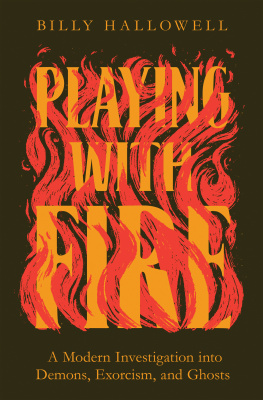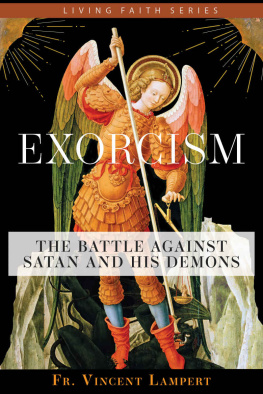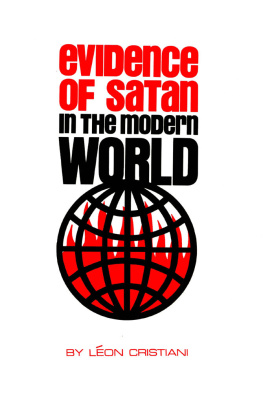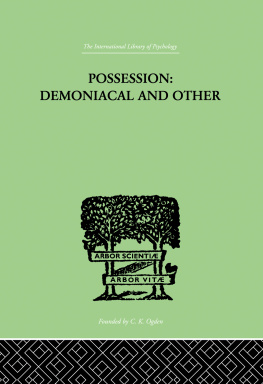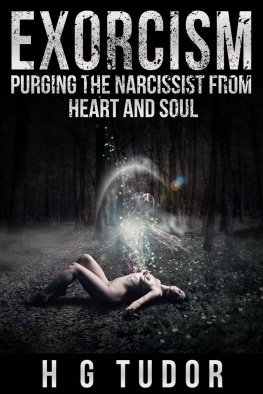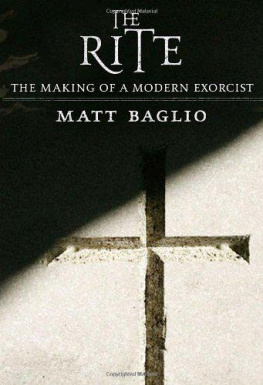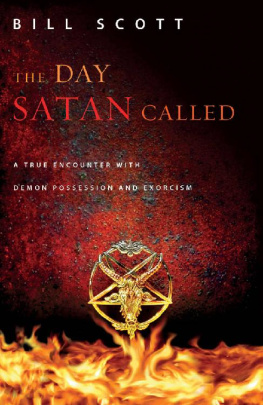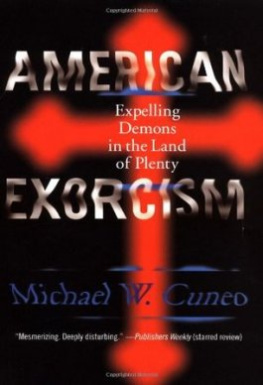1988 by Felicitas D. Goodman
All rights reserved
No part of this book may be reproduced or utilized in any form or by any means, electronic or mechanical, including photocopying and recording, or by any information storage and retrieval system, without permission in writing from the publisher. The Association of American University Presses Resolution on Permissions constitutes the only exception to this prohibition.
Manufactured in the United States of America
Library of Congress Cataloging-in-Publication Data
Goodman, Felicitas D.
How about demons?
(Folklore today)
Bibliography: p.
Includes index.
1. Demoniac possession. 2. Exorcism. I. Title.
II. Series.
BF1555.G66 1988 291.216 87-45403
ISBN 0-253-32856-X
ISBN 0-253-20467-4 (pbk.)
4 5 6 7 99 98 97
To my grandchildren
Charles Andrew
Eleanor Amy
Sarah Daniels
Andrew Murphy
Jason Ananda
Seth Joshu
Foreword
Every time we acquire knowledge we enlarge the world, the world of man, by something that is not yet incorporated in the object of the knowledge we hold, and in this sense a comprehensive knowledge of man must appear impossible.
Michael Polanyi, The Study of Man
Folklore Today, the title of this new series, is more meaningful than it would seem at first glance. It not only implies the reportage of current trends in the discipline of folklore, information on the latest findings and thoughts of scholars, but, more important, it addresses the presentation of new, or old but earlier unrecognized, folkloric phenomena and the research methods and theories that resulted from their discovery and investigation.
Folklore, as a constituent segment of culture, is a dynamic force in any permanent or temporary population group of modern complex societies. It appears as an endless continuum, relating the past with the present and aiming at the future. Thus, it emerges as a historical process in which tradition and innovation play equally important roles, although they do not always appear in equal measure. The folklore corpus of a given social group is an intricate complex of old, new, and restored personal and communal elements in diverse stages of integration and disintegration. Tradition accommodates, shapes, adjusts, and at the same time promotes new ideas following the dictum of actual needs. The interdependence of the two results in both the solidification of universal formulas and the creation of innumerable local-temporal variables. Hence, no new creation can be understood without familiarity with the previous stages, or indeed the total process. But if folklore is a process to be viewed diachronically, it is also a product of existing social conditions to be examined empirically in the context of the cultural, economic, technological, and ideological present responsible for its actual formulations. The dialectic relation of these two characteristics of folklore calls for an interdisciplinary extension of approaches, essentially historical, sociological, and anthropological. The books in this series will demonstrate the benefits of placing the science of folklore between the social sciences and the humanities.
European and American schools of folklore became increasingly more aware of the need of this extension, particularly prompted by the radical and speedy transformation of folk culture after the end of the Second World War. A new generation of scholars took issue with the premises that called folklore into existence in the nineteenth century and that had dominated its trends up to the first four decades of the twentieth. Research goals of this discipline were subjected to national interests and maintained an essentially ethnocentric-romantic bias, preventing scholars from developing an objective scientific inquiry. The folk was understood as the lowest layer of society, which in its underprivileged condition unconsciously preserved the genius of nations expressed by the great poets of a distant golden age. Consequently, the lore of the folk gained national prominence, and its research (serving the practical goal of indoctrination in order to restore and strengthen national cultural unity on the basis of historic values) was celebrated as an ideological discipline. Folklore as heritage: primitive or naive aesthetics was regarded as a model for artists to create an original national art; folklore as ideological weapon was to set the patterns of a distinctive national identity whereby independence and political power would be achieved. Restoration, revitalization, and broad public application of carefully selected archaic folklore under the guidance of professional folklorists grew into a mass movement nationally as well as internationally. As a result of the interaction of the folk, the folklorist, the applier, and the consuming public, we experience the boundless dissemination of folkloric phenomena. The academic, the applied, and the recreational mass use and manipulation of accessible, indigenous, as well as relocated folklore materials, taken from various sources, ensure the flow of folklore from the folk through several hands back to the folk for screening, regeneration, and perpetuation.
The recognition that folk and folklore exceeds earlier narrow confines and that folkloric and nonfolkloric phases cannot be separated from each other within the processes of transmission, spread, and transformation in society prompted modern folklorists to divert their interest
The idea of breaking away from historic reconstruction of an eclipsed folk culture from its rudiments and turning to the current life of people in the country and in the city was launched already in the early thirties.
It seems evident that folkloristics had to give up its original claims to fulfill its mission in the modern world, which, in addition to the transformation of the agricultural masses, has experienced never-before-anticipated cultural consequences of population explosion, and the homogenizing effect of mass information and consumer service through advanced electronic technology. Modern sophisticated tools are needed to investigate folk society and culture, framing creative processes of the contemporary folk. The creative fantasy of the folklorist, so much in action during the romantic era, does not work anymore to help the interpretation of folklore. We have to ask the folk about the realities of the world.
This suggestion was already made eighty years ago. Lajos Klmny (18521919), village parson and pioneer collector of oral literature, was on good terms with his parishioners. He was a jolly peasant priest who helped with the harvesting and gave a hand when the pigs had to be neutered. His Sunday school was fun for the children. Instead of listening to religious exhortations, they wrote their jingles and stories into a copybook. In an era of search for the mythopoetic age, Klmny devoted his time to individual storytellers and singers. Recording repertoires, he did not discriminate the genuinely oral text from materials of literary origin. He studied the process of folklorization of foreign elements. In doing so, he came to the understanding that the folk poets perspective departs from the present reality of his world and that the messages contained in poetic utterances are existentially relevant. In his scattered notes and unfinished essays, Klmny carefully documented this observation:



